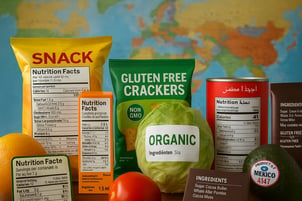Key Differences Between PIM and PLM Systems
Introduction
As you pick up a vitamin bottle or a loaf of bread from a store, have you ever stopped to think how it came to you safe, reliable, and ready for consumption? Most people don’t. Yet, behind the scenes, a careful approach guarantees that each product complies with high safety and quality standards.
At the heart of this process lies Good Manufacturing Practice - the meticulous system that guarantees that products are safe, effective, and consistent. GMP is not just about regulations; it’s a commitment by research & development, suppliers, manufacturers, and retailers to deliver what they promise - products that consumers can trust.
What Are Good Manufacturing Practices (GMP)?
GMP refers to a set of guidelines that ensure the consistent quality, safety, and efficacy of products. These practices span the entire product lifecycle—from raw material procurement to packaging and distribution. Key international institutions like World Health Organisation (WHO) guidelines, FDA regulators, and ISO standards define these principles around the world.
These core principles form the foundation of manufacturing practices that ensure companies maintain global-quality benchmarks.
GMP guidelines
-
Personnel - hygiene rules must include protective clothing, cleanliness, and avoidance of product contamination.
-
Premises — facilities should be designed to minimise contamination risks and allow easy cleaning and maintenance.
-
Raw materials and Packaging Materials — materials and packaging components are inspected, tested, and approved before use, packaging materials should protect the products, and the labels must comply with regulations.
-
Equipment - must be validated to perform consistently under specified conditions.
-
Environmental check - monitoring of air, water, and surfaces ensures contamination risks are controlled.
-
Production - control each step of the manufacturing process to ensure consistency and quality of the finished product.
-
Quality control - testing, verification and validation at every stage of the product life cycle.
-
Deviations and recalls - SOPs must be documented, deviations and corrective actions should be implemented to prevent recurrence. Procedures must be in place for efficiently recalling defective products from the market.
Challenges in GMP compliance
Adopting and maintaining GMP compliance is a challenging task, and manufacturers often face the following problems:
-
Financial Budgets: Setting up GMP-compliant manufacturing practices can be costly for small businesses.
-
Training Gaps: Ensuring that every employee fully understands GMP protocols is a continuous challenge.
-
Regulatory Challenges: Because of the varying GMP standards across different regions, the compliance has become a significantly difficult aspect for global manufacturers.
-
Also, maintaining Data Integrity is a significant challenge in GMP compliance.
-
-
Technological Constraints: Smaller firms may find it difficult to adopt few systems that are required to streamline GMP guidelines.
Industry-wide regulatory directives
Food & Beverage Industries
Non-compliance with food safety regulations can have severe financial and reputational consequences. In 2023, the U.S. Food and Drug Administration (FDA) reported over 200 food product recalls, with a significant portion attributed to undeclared allergens. For example, in 2023, more than 10 million pounds of food products were recalled due to contamination or labelling errors. Additionally, the European Union’s Rapid Alert System for Food and Feed (RASFF) issued nearly 2,000 notifications in 2022 regarding food safety violations, including contamination and misleading labelling.
Pharmaceuticals
Non-compliance with Good Manufacturing Practices (GMP) remains a critical concern in the pharmaceutical sector. In 2023, the U.S. Food and Drug Administration (FDA) issued more than 200 warning letters and observations related to GMP violations, including issues like inconsistent testing, improper handling of raw materials, and failure to follow established procedures. These violations can result in significant financial penalties, recalls, and disruption of operations. A key example of this is the FDA's ongoing scrutiny of pharmaceutical manufacturing facilities, where violations of GMP protocols lead to product recalls and heavy fines, often exceeding millions of dollars. These trends emphasise the importance of strict adherence to GMP to maintain product safety, meet regulatory standards, and avoid costly consequences.
Cosmetics & Personal Care
In recent years, safety and quality control have become a significant focus in the cosmetics industry. According to the U.S. Food and Drug Administration (FDA), consumer safety remains a top priority, and products that contain harmful substances, like benzene, which is classified as a carcinogen, must be promptly recalled. In fact, the FDA’s enforcement data shows that between 2019 and 2022, numerous cosmetics, particularly aerosols, were recalled due to contamination with potentially dangerous chemicals. These trends highlight the growing importance of adhering to strict manufacturing protocols and safety standards to protect consumer health.
Role of PLM software in enabling GMP compliance
Product Lifecycle Management software is a powerful tool that aligns with Good Manufacturing Practices by improving documentation, traceability, and quality control. It helps manufacturers streamline compliance and manage product data efficiently.
Essential PLM software features for GMP compliance:
Document Management
A centralised repository for storing, organising, and accessing product-related documents and data securely in the cloud, facilitating seamless collaboration.
Specification Management
Comprehensive handling of all required product data and associated components, including ingredients, materials, packaging, and co-products, ensuring consistency and accuracy.
Formula Management
Systematic definition and organisation of the product creation process by detailing materials, quantities, and process instructions, ensuring products meet predefined specifications.
Product Portfolio Management
Creation of a structured and comprehensive product portfolio to aid in decision-making and strategic planning, ensuring that all products comply with GMP standards.
Conclusion
GMP goes beyond being a regulatory necessity; it is an assurance towards quality, safety, and consumer confidence. With many industries undergoing digital transformation, PLM software has become a vital technology to help facilitate GMP compliance. To help manufacturers meet the complexities of GMP it streamlines processes, ensures traceability, and supports proactive risk management capabilities.
As industries continue to evolve, embracing tools like Plevenn’s PLM platform can empower manufacturers to not only meet GMP standards but also stay ahead in a competitive market!
Feb 6, 2025 10:39:22 AM








